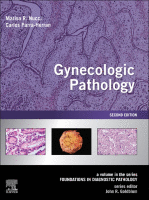Physical Address
304 North Cardinal St.
Dorchester Center, MA 02124

Introduction Cytologic examination is an integral part of gynecologic pathology. Many of the specimens presenting to the gynecologic surgical pathology service originate as the result of abnormal cytology examinations. Moreover, in many practices, the review of concurrent cytology and surgical…

In the last decades, immunohistochemistry (IHC) has seen a marked expansion in application to the diagnosis and prognosis of lesions of the female genital tract. In this chapter, I concentrate on the diagnostic utility of IHC markers in gynecologic pathology…

Gestational trophoblastic disease encompasses a diverse group of trophoblastic proliferations that can be divided primarily into molar and nonmolar lesions. Molar lesions derive from villous trophoblast and include partial (PHM), complete (CHM), and invasive hydatidiform moles. Nonmolar lesions include placental-site…

Diseases affecting the peritoneum are diverse, ranging from reactive to neoplastic, the latter being either benign, borderline, or malignant processes. Among malignant tumors, many are of secondary (metastatic) origin; much less commonly, they are primary Müllerian or mesothelial in nature.…

Metastatic Tumors Involving the Ovary Metastases account for approximately 8% of malignant ovarian neoplasms in women undergoing surgery for an adnexal mass in the United States. Metastases derived from nongynecologic sites are 11 times more common than those originating from…

Germ cell tumors comprise approximately 30% of all primary ovarian neoplasms. The vast majority are mature teratomas representing >90% of neoplasms in this category. Others, called collectively “primitive germ cell tumors,” are rare in Western countries but account for up…

This category includes a diverse group of neoplasms believed to derive from the hormone-producing ovarian cortical stroma. Based on their predominant cell population and appearance, the World Health Organization (WHO) classification divides them into two main categories: (1) pure lesions,…

Epithelial tumors, the most common neoplasms of the ovary, encompass five distinct subtypes. Differentiation into these epithelial cell types is under the control of the same genes that determine different epithelial lineages in the female reproductive tract during embryonic development…

The ovary is a solid organ composed of (1) surface epithelium , an extension of the pelvic peritoneum; (2) the cortex , composed of cellular stroma, follicular units (comprised of a central oocyte surrounded by granulosa and theca cells), corpora…

Nonneoplastic Lesions of the Fallopian Tube The fallopian tubes comprise the most upper portion of the Müllerian tract bilaterally. They are attached proximally to the uterus (intramural portion), whereas the isthmus and the ampulla extend outside of the uterus and…